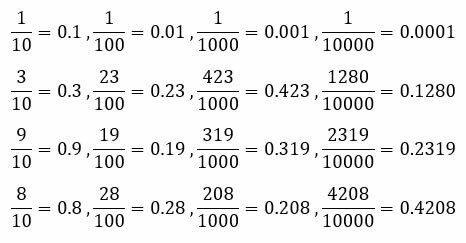Decimal Notation Example
Math / / July 04, 2021
Is named decimal notation to writing decimal numbers. It is based on multiples and submultiples of the number 10. These numbers are used to represent two types of values:
- Quantities that are not enough to complete the whole (1).
- Quantities that exceed the integer (1), but have a surplus.
Characteristics of decimal notation
To better understand decimal notation, we will use an example that starts from a fraction:

(Zero integers, six tenths)
Decimal notation takes into account a number of facts to apply:
- A number (or remainder) less than one is represented as a fraction, with a denominator that is a multiple of 10 (in the example, it becomes an equivalent fraction with a denominator of 10).
- It goes off with a decimal point. The amount will be written to its right.
- The number of zeros (0) in the multiple of 10 will tell us the places to be covered to the right of the decimal point.
Writing decimal numbers
Decimal numbers are written in only one way: the integer part, then the decimal point, and to its right the decimal part. It starts with fractions with a denominator multiple of 10, to better understand this aspect.
3/10 = 0.3
They are three tenths. The denominator is 10, which has a zero (0). A place will be counted from the 3rd, and the decimal point will be placed on the left.
3/100 = 0.03
They are three hundredths. The denominator is 100, which has two zeros (00). Two places will be counted from 3, and the decimal point will be placed on the left. A zero (0) is put in the empty place.
3/1000 = 0.003
They are three thousandths. The denominator is 1000, which has three zeros (000). Three places will be counted from 3, and the decimal point will be placed on the left. A zero (0) is put in each empty place.
23/100 = 0.23
They are twenty-three hundredths. The denominator is 100, which has two zeros (00). Two places are counted from 3, and put the decimal point.
108/1000 = 0.108
They are one hundred and eight thousandths. The denominator is 1000, which has three zeros (000). Three places are counted from 8, and put the decimal point.
Scientific notation
In decimal notation, when the quantities are too small that it is more complicated to write them, the call is used Scientific notation, which is also based on multiples and submultiples of 10. This writing is distinguished by the fact that, since multiples of 10 are very large or very small, exponents are used to define them.
For example, for large numbers:
1,000,000 (one million) = 106
1,000 (thousand) = 103
"The exponent indicates the times that 10 appears in a multiplication by itself"
- 101 = 10
- 102 = 10*10
- 106 = 10*10*10*10*10*10
- 108 = 10*10*10*10*10*10*10*10
- 109 = 10*10*10*10*10*10*10*10*10
For example, for small numbers:
0.000001 (one millionth) = 10-6
0.001 (one thousandth) = 10-3
"The exponent indicates the places that will be traveled to put the decimal point"
- 10-1 = 0.1
- 10-2 = 0.01
- 10-6 = 0.000006
- 10-8 = 0.00000001
- 10-9 = 0.000000001
- It may interest you: Scientific notation.
Examples of decimal notation
Decimal numbers from fractions

Decimal numbers with scientific notation

Follow with:
- Scientific notation.



